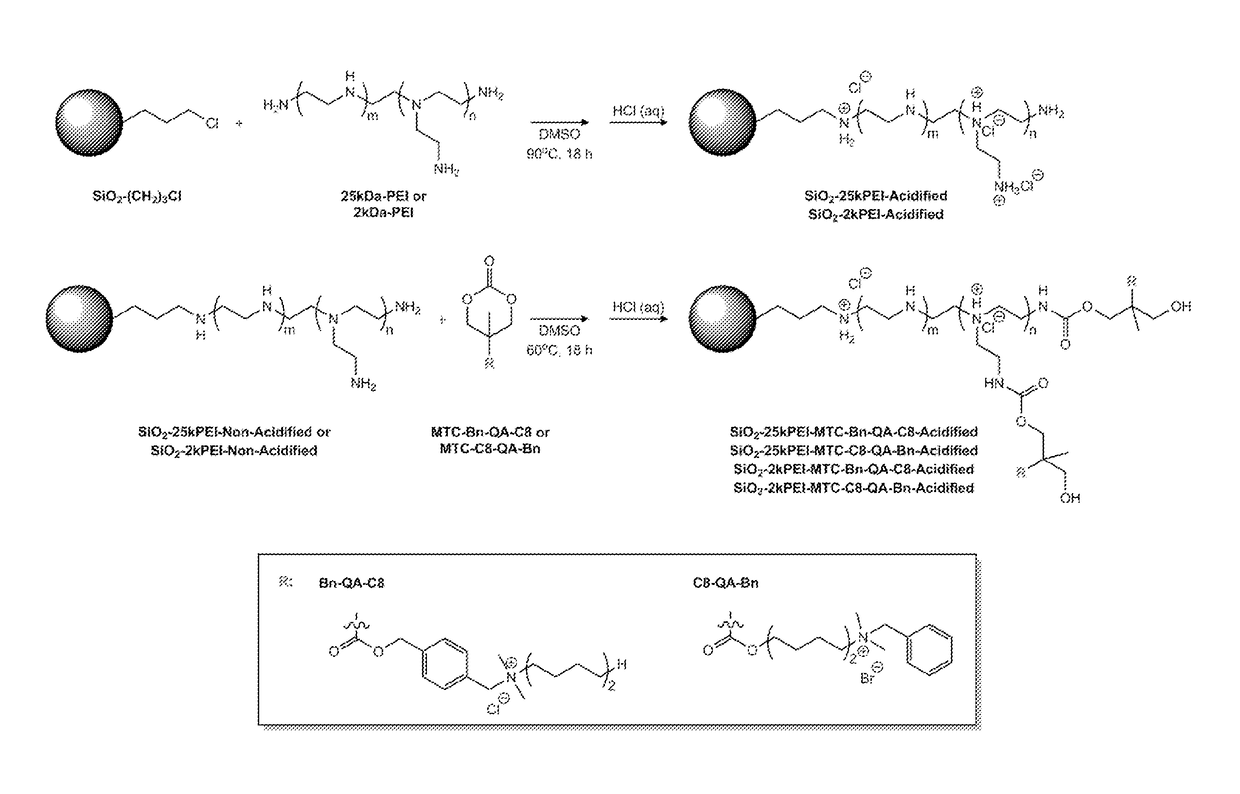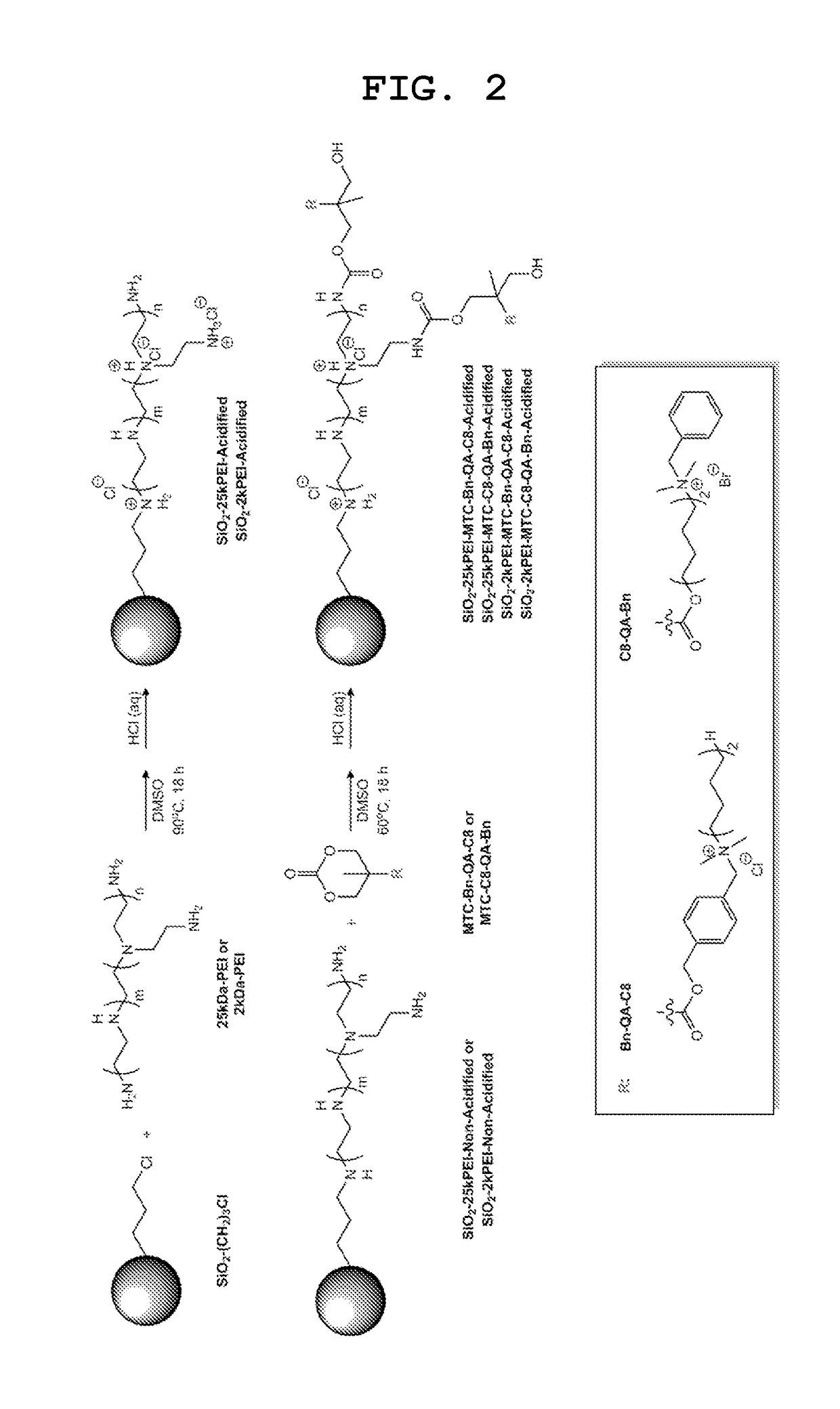Antibacterial particles functionalized with polyalkylene imine and its derivatives for water disinfection
a technology of polyalkylene imine and antibacterial particles, applied in biocide, plant growth regulators, pharmaceutical non-active ingredients, etc., can solve the problems of microbial contaminants in drinking water remaining a health-risk challenge, substantial, adverse or sometimes fatal health consequences, etc., to avoid chemical treatment, facilitate particle functionalization, and high activity
- Summary
- Abstract
- Description
- Claims
- Application Information
AI Technical Summary
Benefits of technology
Problems solved by technology
Method used
Image
Examples
example 1
of PEI-Functionalized Silica Particles
[0088]Branched PEIs of two molecular weights, mainly 25-kDa and 2-kDa PEI, were separately grafted onto SiO2—(CH2)3Cl particles. PEI (5 g of 25-kDa PEI or 2 g of 2-kDa PEI) was first dissolved in 50 mL of DMSO, and SiO2—(CH2)3Cl particles (0.1 g, 0.1 mmol Cl) were added into the polymer solution. The mixture was stirred continuously at 90° C. for 18 h (FIG. 2). The polymer-coated silica particles were rinsed repeatedly with DMSO and followed by water for three times in order to remove unreacted polymer before being dried at 60° C. To protonate the amine groups of the surface-grafted PEI, the polymer-coated silica particles were treated with dilute HCl in excess and incubated in the presence of sonication for 5 min. The acidified particles were then rinsed repeatedly with water until the pH is close to neutral (i.e., pH=7).
example 2
of PEI-MTC-Functionalized Silica Particles
[0089]The amphiphilic cyclic carbonates were grafted onto PEI-coated silica particles via a one-step ring-opening nucleophilic addition reaction. For 25-kDa-PEI-coated silica particles, MTC-Bn-QA-C8 (273 mg) or MTC-C8-QA-Bn (292 mg) was first dissolved in 2 mL of DMSO, before adding PEI-coated silica particles (0.1 g) and trimethylamine (167 μL) into the solution. For 2-kDa-PEI-coated silica particles, MTC-Bn-QA-C8 (253 mg) or MTC-C8-QA-Bn (270 mg) was first dissolved in 2 mL of DMSO, before adding PEI-coated silica particles (0.1 g) and trimethylamine (155 μL) into the solution. In both cases, the cyclic carbonate was added in excess with respect to the primary amine groups of PEI. The mixture was left to stir continuously at 60° C. for 18 h. After 18 h, the PEI-MTC-coated silica particles were rinsed repeatedly with DCM for three times in order to remove unreacted carbonates before being dried in vacuo. To protonate the amine groups of the...
PUM
| Property | Measurement | Unit |
|---|---|---|
| Size | aaaaa | aaaaa |
| Size | aaaaa | aaaaa |
| Atomic weight | aaaaa | aaaaa |
Abstract
Description
Claims
Application Information
 Login to View More
Login to View More - R&D
- Intellectual Property
- Life Sciences
- Materials
- Tech Scout
- Unparalleled Data Quality
- Higher Quality Content
- 60% Fewer Hallucinations
Browse by: Latest US Patents, China's latest patents, Technical Efficacy Thesaurus, Application Domain, Technology Topic, Popular Technical Reports.
© 2025 PatSnap. All rights reserved.Legal|Privacy policy|Modern Slavery Act Transparency Statement|Sitemap|About US| Contact US: help@patsnap.com



